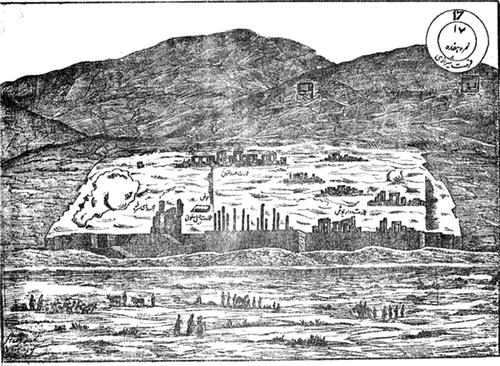Fursat’s observations of Âsâr-i ‘Ajam
The narrative of Âsâr-i ‘Ajam proceeds by diversions and detours that correspond to Fursat’s travels. To expand and clarify findings, Fursat subsequently interspersed the travelogues with chapters written once he returned from his journeys. The bulk of the information in the Âsâr-i ‘Ajam comes from Fursat’s observations, supplemented by the books he had at his disposal and the encounters he chanced upon. Fursat deals with topics as practical problems and seeks to discuss them with the conceptual tools and information he has, aware of the limits and shortcomings of his
knowledge.
Fursat’s book
Fursat’s engagement with the territory of Âsâr-i ‘Ajam is intertwined with his studies of ancient Iranian languages and his linguistic experimentations. His progressive acquaintance with the ancient world and its scripts is an integral part of Âsâr-i ‘Ajam. The book, like Fursat’s poetry,exhibits neologisms derived from the neo-Mazdean texts that were popular at the time. The language fits the topic. As Tavakoli-Targhi (2001) writes, this literary fashion was a linguistic experimentation, a sign of distinction.

pure Persian
Later modernist literary critics and philologists searching for “pure Persian” sanctioned these experiments as unsuccessful and artificial. They are not a return to an older style but an exploration of a different lexical ground. The notes on the margin give the vocalization of these words and explain their meaning.At the same time, in apparent contradiction, Fursat insists that he wrote the book in easy readable prose, without ornaments and rhymes (sajj) (Fursat 1896: 8). However, the prose is often interspersed with verses.
In several instances, Fursat recounts the occasion for composing a poem and then quotes it in its entirety. Often these poems are qasîdas dedicated to his hosts or to a figure he admires. The alternation of prose and verse is common in Persian writing and has its ultimate model in Sa‘dî’s Gulistân. In Fursat, this habitual decorative gesture turns the Âsâr-i ‘Ajam into a poetic journey. ccompanied by the mention of numerous ancient and contemporary poets, the alternation of prose and verse territorializes poetry as one of the components of the material and conceptual landscape Fursat is delineating. Ultimately, Fars and, more specifically Shiraz, are poetic territories.

